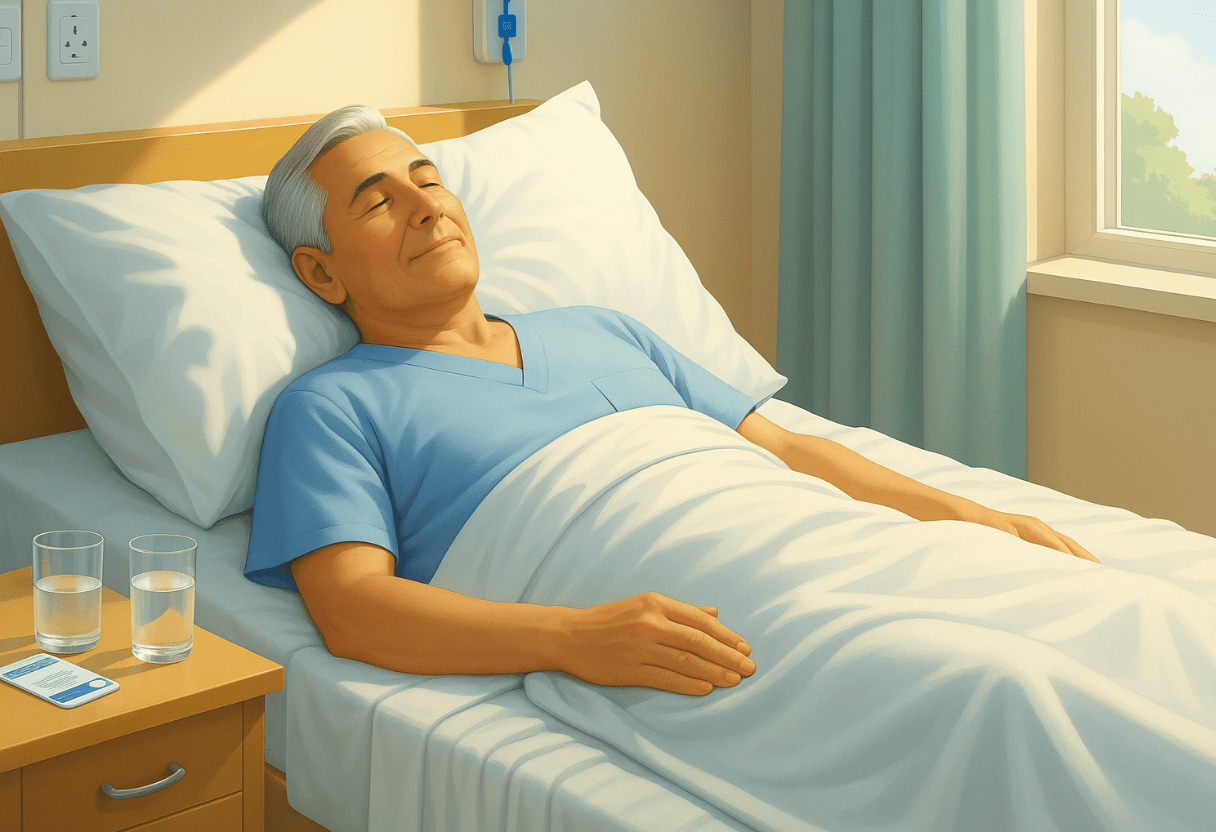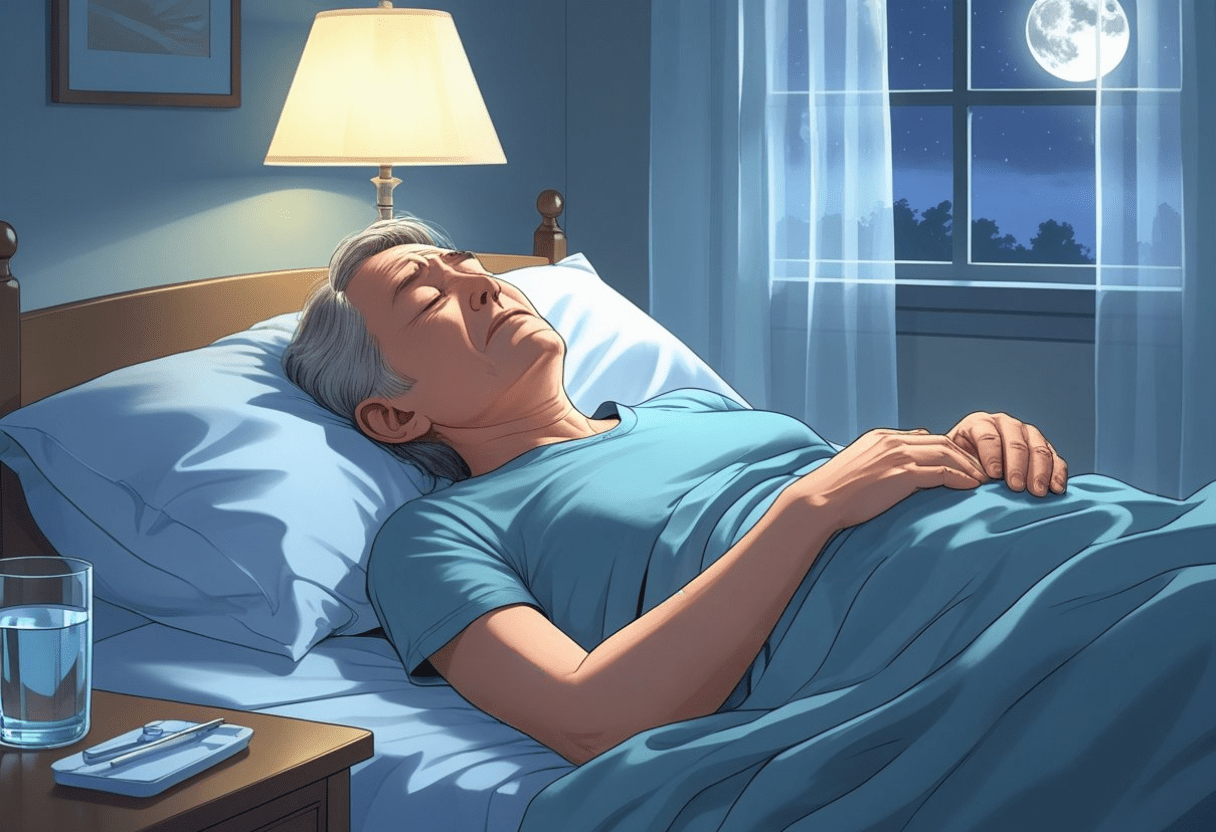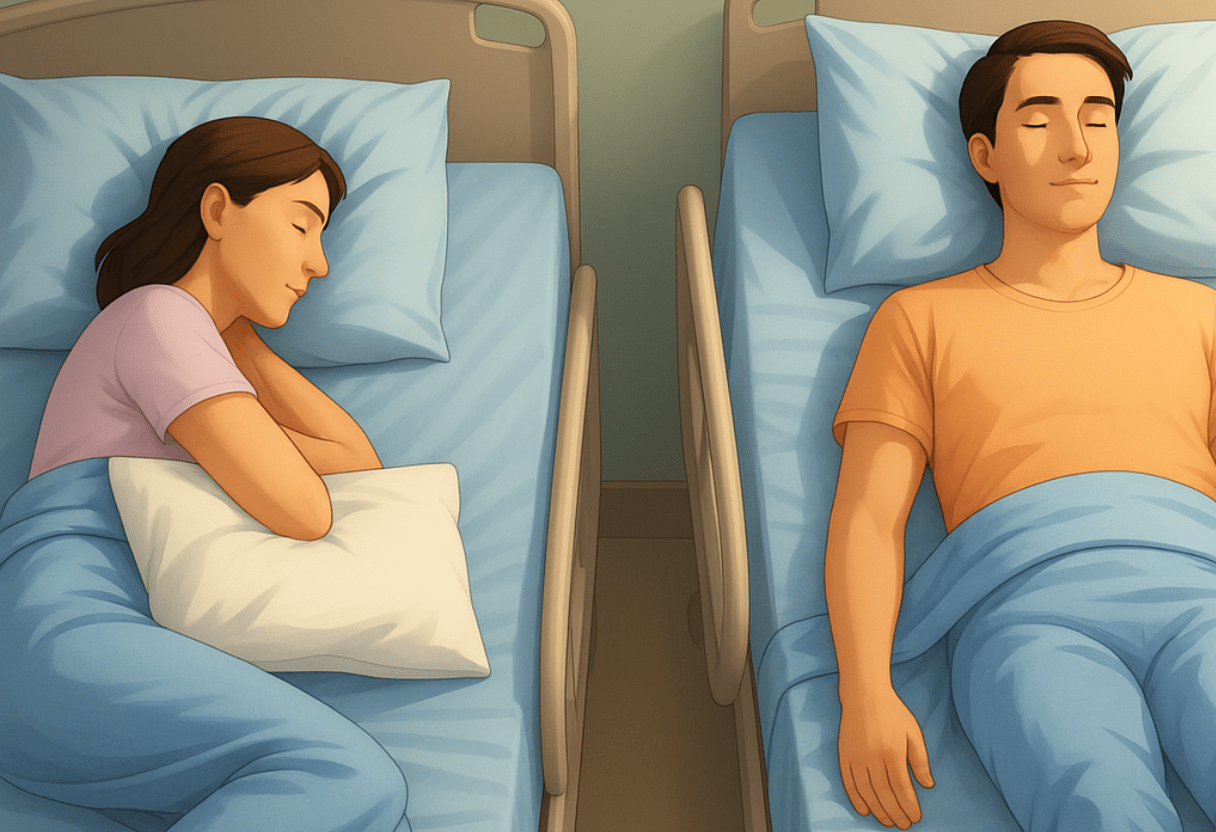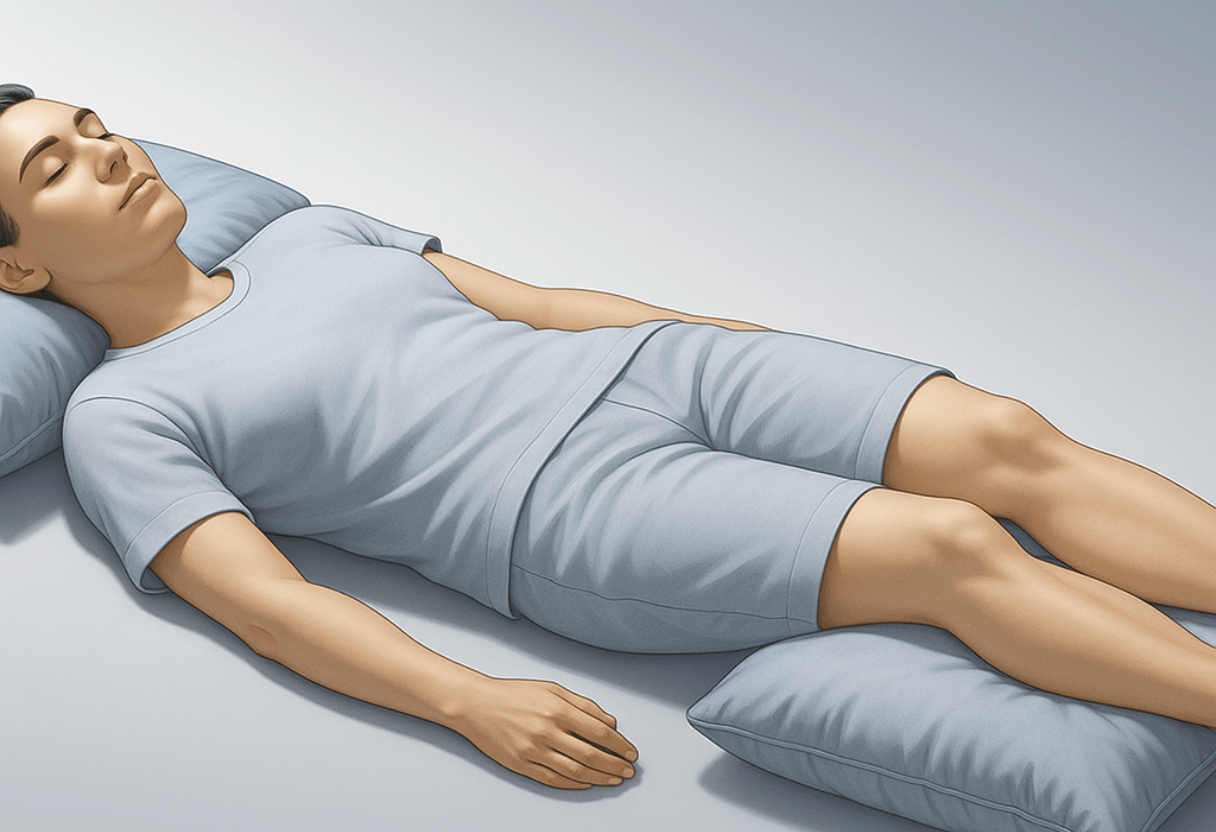Recovery from gallbladder surgery can make sleeping uncomfortable. Pain, bloating, and soreness around the wound are common. Sleeping on the back or left side helps reduce pressure on the right side where the surgery was done. Using pillows can make rest easier. Placing one under the knees or between the legs while on the left side keeps the body aligned and eases pressure on the abdomen. Pain medication and a quiet, dark room also support better sleep.
Good sleep habits help the body heal faster. They can reduce complications and make recovery smoother. Following these routines allows a person to get back to normal activities more quickly.
Key Takeaways
- Sleeping on the back or left side reduces pressure on surgery sites.
- Proper pillow support ensures body comfort and alignment.
- Pain control and sleep-friendly surroundings improve sleeping quality.
- A mattress that supports posture, relieves pressure, and promotes comfortable sleep after gallbladder surgery.

Understanding Sleep Challenges After Gallbladder Surgery

Sleep usually feels harder after gallbladder surgery. This happens for several reasons, such as pain from the surgery, changes in how you usually sleep, and the body’s recovery process. Knowing what to expect makes it easier to manage rest while healing.
Rest Disturbances Encountered During Recovery
Many people struggle to fall asleep or stay asleep in the first few days after surgery. The body also loses more REM sleep at first, which lowers overall sleep quality.
Bloating is another common problem. During surgery, gas is put into the abdomen, and some of it can stay inside afterward. This gas causes pressure and discomfort, especially in the first day or two. Sleeping positions can also make things harder. Lying on the right side presses directly on the incision, which can be painful. Because of this, people often wake up at night to shift positions. Anesthesia can add to the problem too, sometimes causing trouble sleeping for several days.
Impact of Pain and Discomfort on Sleep
The main reason sleep is disrupted after gallbladder surgery is pain around the incision site, usually on the right side where the gallbladder was removed. Bloating makes it worse since lying flat or on the stomach puts more pressure on the area. Doctors usually suggest sleeping on your back or left side to avoid strain on the incision. Managing pain with prescribed or over-the-counter medication can make a big difference. Taking medicine before bedtime can lower the chances of waking up in the night.
Pain also makes moving in bed more difficult, which can cause stiffness and soreness when getting up. With steady pain control and slowly adjusting sleeping positions, it becomes easier to rest comfortably during the early stages of recovery.
Best Sleeping Positions After Gallbladder Surgery
Positioning oneself into a good sleeping position is most essential in order to reduce pain and protect healing tissues upon gallbladder surgery recovery. Having the right position helps avoid pressure on your incisions and can reduce bloating and discomfort. Supporting the body properly should come first, especially to avoid strain on the right side of the abdomen.
Back Sleeping for Ultimate Comfort
Sleeping on your back is usually the best option after gallbladder surgery. It takes weight off the right side, where the incisions are. Back sleeping helps lower pressure on the wounds and limits irritation. Adding a pillow under the knees can reduce tension in your lower back. A small, firm pillow behind your lower back gives extra support. Many patients also like to keep their head slightly raised to ease bloating or gas.
Back sleeping keeps movement away from the surgery site. This can help you heal faster and manage pain better. Most people can start back sleeping right after surgery and continue until it feels comfortable.
Left Side Sleeping and Positioning Support
If you prefer or need to sleep on your side, the left side is better. This keeps pressure off the right side where the gallbladder was removed. Sleeping on the left can ease soreness and prevent stretching your incisions. Try to keep your body straight instead of curling into a ball. A pillow between the knees can help align your spine and reduce hip strain. Hugging a pillow can also prevent rolling onto the right side during the night.
Doctors usually suggest waiting at least two weeks before sleeping on the right side. Side sleeping should be resumed slowly after swelling and pain have improved.
Elevated and Reclined Postures
Raising the upper body while sleeping can lower abdominal pressure and make breathing easier. Using an adjustable bed or stacking pillows at a 30- to 45-degree angle can ease pain from swelling or gas. Sleeping higher can also help reduce nausea and improve digestion after meals. It takes pressure off your incisions in the first week and supports core muscles. You can experiment to find the most comfortable incline. Adding extra pillows for the head can prevent neck strain.
When to Avoid Stomach and Right Side Sleeping
Sleeping on your stomach puts direct pressure on your surgery area and should be avoided for the first 4 to 6 weeks. This can irritate incisions and increase pain. Right-side sleeping is also not recommended during early recovery. It can put pressure on fresh wounds, causing swelling and discomfort. Most patients are told to avoid the right side for at least two weeks, depending on pain and doctor guidance.
Focus on sleeping on your back or left side until your body is ready. Trying stomach or right-side sleeping too soon can slow healing. If you’re unsure about changing positions, check with your doctor.

Using Pillows and Supports for Better Sleep
Proper pillow and support utilization can alleviate pain and improve quality of sleep after gallbladder surgery. Correct pillow use helps reduce pressure on sensitive areas and keeps the body stable through the night. Using pillows in the right way can make sleeping more comfortable while healing.
Pillow Placement Techniques
How you place pillows can make lying down easier. Putting a pillow behind your back while lying on your left side can stop you from rolling onto your right side, where the incisions are. If you sleep on your back, a pillow under your knees reduces pressure on your abdomen. On your side, a pillow between the knees keeps your hips aligned and eases strain. You can stack a few pillows to tilt your upper body slightly. This may help with bloating and digestion.
Guarding Incision Sites
Avoid putting direct pressure on the right side where the gallbladder was removed. Pillows can cushion the area and take weight off the incision. Soft pillows gently protect the surgery site. A small firm pillow or folded towel on each side adds extra protection without causing discomfort. Choosing breathable pillow material prevents skin irritation around sensitive areas.
Preventing Unwanted Movement
Stable pillow support can stop sudden movements that might hurt. Pillows help prevent rolling over during sleep. Placing pillows snugly around the body keeps you in the best sleeping position, like on your back or left side. Stacking or wrapping pillows close can limit movement and let your body rest while healing.
Using proper pillow support is one of the simplest ways to improve sleep after gallbladder surgery.

Pain Management Strategies to Enhance Sleep
Good control of pain is necessary to improve sleep following gallbladder surgery. A mix of medication and drug-free strategies can ease discomfort and facilitate resting.
Medication and Timing for Nighttime Relief
Taking pain medicine regularly can stop discomfort from waking you at night. Over-the-counter options like ibuprofen or naproxen can help with both inflammation and pain. It’s usually best to take them about two hours before bed so pain doesn’t disturb sleep.
If pain is stronger, a doctor may prescribe stronger medication. Following the instructions for dose and timing is important. Taking medicine with food can reduce nausea. Keep pain medicine by your bed so you can take another dose if needed during the night, but don’t overuse it. Any side effects should be told to your doctor.
Non-Pharmacological Measures to Lessen Discomfort
You can also reduce pain without medicine. Sleeping on your back or left side can lower pressure on the surgical area. Using pillows under your knees or around your body can make these positions more comfortable. A calm bedroom helps too. Dark curtains, eye masks, and earplugs can reduce distractions and let you relax. Light exercise during the day, like walking, can prevent bloating that causes nighttime pain.
If your doctor allows it, a warm compress on the area before bed can relax muscles and ease soreness. These small steps can make falling and staying asleep easier after surgery.

Creating a Sleep-Friendly Environment

A restful sleep area after gallbladder surgery reduces discomfort and aids in more rapid healing. Modifying light, sound, bedding, and room temperature makes sleeping easier and more refreshing.
Managing Room Lighting and Sound
Keeping the room dark helps you sleep better. Blackout curtains block outside light that can disturb rest. If you don’t have curtains, an eye mask works well. Noise can wake you up after surgery. Earplugs or a white noise machine can cover traffic or household sounds. Turning your phone on silent and disabling notifications also prevents sudden disturbances.
A tidy room supports relaxation. Getting the sleep area ready before surgery, with supplies within reach, reduces the need to get up at night.
Optimal Bedding and Room Temperature
Comfortable bedding helps reduce pressure on the surgery area. Soft, breathable sheets like cotton or moisture-wicking fabrics keep skin dry. Pillows can support your side or back, especially around the right abdomen. Keep the room cool but not cold, around 60°F to 67°F (15°C to 19°C). A lower temperature helps the body relax and fall asleep faster. A fan or thermostat can help maintain this.
Changing bed linens keeps the space clean and prevents skin irritation. Keeping water and medicine nearby also reduces the need to leave bed.
Additional Tips and Lifestyle Adjustments for Recovery

Proper sleep following gallbladder surgery isn’t just about which position you sleep in. Small habits can make a big difference. Handling pain, digestion, and comfort before bed can help you rest better. Light activity and reducing bloating also help the body heal faster.
Pre-Bedtime Activities for Relaxation
A simple routine before bed can lower stress and prepare the body for sleep. Try staying away from screens or bright lights for at least 30 minutes. Reading a book or listening to quiet music can help you unwind.
Using an essential oil diffuser with scents like lavender or chamomile may help you relax. Taking over-the-counter pain medicine an hour or two before bed can keep discomfort from waking you up. Going to bed at roughly the same time each night helps the body keep a steady sleep rhythm. A dark, cool, and quiet room makes it easier to fall asleep and stay asleep.
Dietary Considerations and Digestion
After gallbladder surgery, smaller, lighter meals can prevent discomfort at night. Foods like broth, crackers, or bananas are easy on the stomach. It’s best to avoid fatty, spicy, or processed foods before bed. Alcohol and caffeine can upset digestion or affect sleep, so limit them while recovering. Drink water during the day, but slow down near bedtime to avoid late-night trips to the bathroom. Eating slowly and chewing well helps the body adjust to life without a gallbladder and can prevent gas or bloating that interrupts sleep.
Light Physical Activity and Sleep Quality
Gentle daily walks, if your doctor approves, can help reduce bloating and improve circulation. Light movement helps digestion and can ease discomfort at night.
Avoid heavy exercise or anything that strains the abdomen until your doctor says it’s okay. Moving gently during the day can also lower stress and help you sleep better. Balancing activity with enough rest keeps the body from getting stiff and supports healing.
Gas and Bloating Symptom Management
Gas and bloating are common after gallbladder surgery. They happen because digestion changes and leftover air builds up in the stomach. This can cause pressure and make it hard to sleep.
Over-the-counter medicine like Gas-X (simethicone) can help, but only if your doctor says it’s safe. Simethicone breaks up gas bubbles and eases pain. Wearing loose clothes and not lying flat right after eating can reduce gas buildup. Sleeping on your back or left side can ease abdominal pressure. A warm compress on the stomach can also help. If gas or bloating lasts more than a few days or gets worse, check with your doctor.
Choosing the Right Mattress for Post-Gallbladder Surgery Comfort
The right choice of mattress matters for support and recovery after gallbladder surgery. A mattress that provides proper support helps reduce pressure on your abdomen. It also makes it easier to get a good night’s sleep. Mattresses that are balanced in softness and firmness work best. A mattress that is too soft lets your body sink, which can strain sensitive areas. On the other hand, a mattress that is too firm can create pressure points and feel uncomfortable.
Hybrid mattresses with innerspring coils and foam layers are often a better option as they give both support and cushioning, which can lower pain while sleeping. Models with lumbar support, like the Helix Midnight Luxe mattress, are especially helpful for those who need pressure relief without giving up comfort.
The Helix Midnight Luxe mattress works well for recovery. It combines comfort with zoned lumbar support to keep pressure off your midsection and maintain spine alignment. This is important after gallbladder surgery. Its Tencel cover breathes well, and cooling systems help prevent overheating at night. Heat-trapping mattresses should be avoided because excess warmth can irritate healing skin. Materials that allow airflow or have gel cooling layers keep you comfortable all night.
The best mattress after gallbladder surgery is one that supports good posture, reduces pain, and allows uninterrupted sleep. This helps the body heal more effectively and ensures recovery is as smooth as possible.

Frequently Asked Questions
Sleeping well after gallbladder surgery takes care and attention. Your body needs time to heal, and how you move or sleep can affect recovery. Men and women may experience different levels of discomfort, and using proper techniques can make resting easier.







